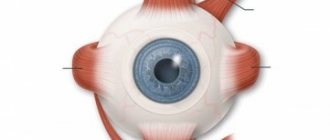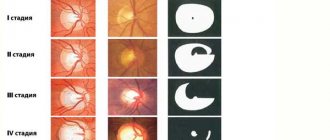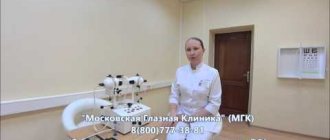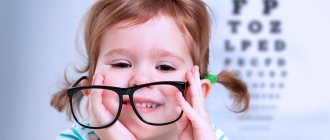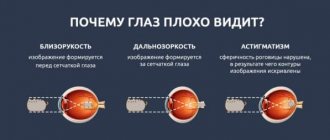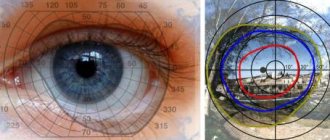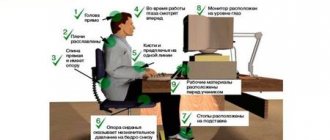Psychological characteristics of children with visual impairments
In the formation of the psyche of children with visual impairments, it is necessary to proceed from the capabilities and needs of children, taking into account their characteristics associated with visual impairment. The characteristics of children that distinguish them from their peers with normal vision appear already at the first meeting.
- not very well coordinated, insufficiently focused, uncertain movements (insufficient range of movements)
- eye contact, communication with gestures - limited or almost absent
- Speech contact is better organized, but children three to four years old in most cases have delayed speech development. In older children, there are often signs of speech disinhibition and verbalism (the child may talk a lot about abstract things, and not be able to answer a specific question about the world around him, or compose a simple story from a picture).
- in tests for dynamic praxis and reciprocal coordination, most children experience significant difficulties. Finger tests perform better.
The examination procedure may take 1.5-2 times longer due to the fact that a visually impaired child needs to be given more time to complete the task due to difficulties in perception and slow processing of information, as well as due to difficulties in organizing the child’s activities, inaccuracy of movements, etc. They are characterized by great uncertainty about the correctness and quality of work, which is expressed in more frequent requests for help in assessing activities from an adult, translating the assessment into a verbal communication plan.
Many children need additional stimulation to maintain attention and encouragement to complete a task due to the child's uncertainty, stiffness and indecisiveness.
Visually impaired children differ greatly from each other in their state of vision, performance, fatigue and speed of assimilation of material. This is largely due to the nature of the visual impairment, the origin of the defect and the personal characteristics of the children. Children in the same age group, having approximately the same visual diagnoses, can differ greatly in their level of intellectual development and psychoneurological status.
Violations in the emotional-volitional and communication spheres - as a rule, children with visual impairments are characterized by increased emotional vulnerability, resentment, conflict, tension, and inability to understand the emotional state of a communication partner and adequate self-expression.
The games of such children are characterized by less development than the games of ordinary children; they require the organizing help of an adult to a greater extent, at first throughout the game. The rules of the game have to be repeated many times, and although children’s actions are, as a rule, stereotypical, fragmented perception prevents them from maintaining a holistic image of the game plot. Difficulties in mastering objective actions lead to the fact that many children, even of older preschool age, remain at the level of objective-practical activity in their spontaneous behavior.
Visual impairment is also associated with difficulties in motor development: the lack of stereoscopic perception, the monocular nature of vision in children with amblyopia and strabismus reduces the motor activity of children.
Having less mobility and little experience of communication, they are poorly oriented in the elements of expressive movements of the body and poorly use gross motor skills to express their feelings and desires, thereby not creating for themselves a system of motor images that reflect the attitude towards objects and subjects of communication, and do not have clear images expressing your feelings in pantomime. As a result, there is a misunderstanding of the language of pantomime among others and difficulties in one’s own communications.
In addition, children with visual impairments, especially when communicating at a distance, are characterized by inaccurate perception of gestures due to decreased acuity of central vision and impaired binocularity. They use gestures less often and only, as a rule, to clarify verbal information, which is due to the immaturity of non-verbal communication means. Noteworthy is the fact that it is very difficult for such children to hear another child, their speech is usually monologue, and they have very little interest in what their play partners say. On the one hand, this may be due to a lack of perception; on the other hand, it may be due to the influence of protective upbringing in the family.
The behavior of children with visual impairments in most cases lacks flexibility and spontaneity, and non-verbal forms of communication are absent or poorly developed. They are characterized by stereotypies - the inert attachment of a word to the image of one specific object or phenomenon inhibits the activity of the imagination, prevents the use of words and concepts in non-standard situations, combining and creating new images.
As a result, the content of the stories invented by children contains few of their own plots. They mainly feature paintings and excerpts from famous fairy tales and stories. But they also suffer from stereotyping, low variability, and lack of integrity; emotionality, originality and completeness of the narratives are poorly demonstrated.
The study of the creativity of children with visual impairments shows the influence of visual impairment on the pace of development of creative creative play and requires a special correction, a training stage aimed at firmly mastering the methods of play action, expressing their emotions, which in the future allows children to show and develop their creative potential.
Of course, the general somatic weakness of children attending a correctional preschool institution also matters. An increasing number of children entering kindergarten, in addition to eye diseases, have concomitant disorders of the central nervous system, musculoskeletal system, and other organs. If we add to this circumstance the fact that a child with impaired vision has to work much harder to receive and process the ever-increasing flow of information that surrounds him today from all sides, it becomes clear that such stress cannot but affect the child’s fragile psyche . As a result, the insufficient formation of voluntary mental processes and the emergence of a passive position in relation to the environment, which causes negative emotions in him, slows down and complicates the process of developing self-regulation.
In order to find out the degree and level of ability for self-regulation, it is necessary first of all to find out the child’s knowledge of himself, the presentation of his external image, knowledge of the capabilities of his senses, which are formed on the basis of his own tests, checks of his physical qualities, motor abilities and understanding of what he like or dislike what he can or cannot do.
Specificity compared to the norm is in most cases quantitative - those with normal vision have more and more complete verbal descriptions, although they also do not use specific designations of color and shape.
Almost all children with amblyopia and strabismus do not talk about the sense of touch as a means of understanding the world around them, but highlight the function of the hand as support when falling, i.e. assistance to vision, which characterizes difficulties in movement and orientation in space, while those with normal vision highlight the tactile function of the hand in communication and in the knowledge of surrounding objects. This indicates that, despite the shortcomings of visual perception, children with amblyopia and strabismus rely mainly on it, weakly using touch, hearing, taste, smell, etc.
Ready for school
By the age of 7, the child experiences difficulties in perception due to a change in the leading activity from play to learning: he “begins to withdraw and becomes uncontrollable.”
Diagnosis of readiness for learning at school is carried out in preparatory groups annually in April-May. The survey results show that children attending correctional kindergarten are generally well prepared for school; from 40 to 60 percent of children have high scores in this test.
The technique includes the following tests:
- "Find the rule." Demonstrates the ability to find a pattern.
- "Checking in the house." Reveals the level of development of logical combinatorial thinking.
- "Schematic recording of words under dictation." Reveals the level of development of phonemic hearing.
- "Meaningless syllables." Determines the development of fine motor skills of the hand.
- "Attention. Orientation. Quantity" Reveals the level of development of attention, the ability to orient in space, and the formation of the idea of quantity.
- “Invitation to visit” - determines the level of development of visual-schematic thinking, the ability to use the rule.
Most often, children cope better with tasks on logical thinking and phonemic awareness, and they also do well with writing nonsense syllables and with orientation tasks. Difficulties often arise when performing the “Moving a House” test (for combinatorial skills) and in the task of determining quantities, especially the more-less ratio.
The number of children with a low level of school readiness is usually from 10 to 20 percent of the total number of kindergarten graduates.
The 7-year-old crisis, which occurs in children with normal vision, is characterized by three main symptoms:
- loss of spontaneity,
- mannerisms,
- "bittersweet" symptom.
This age period is associated with the transition to a new leading activity for children - learning. A change in leading activity presents the child with new demands that he must accept while performing the functions of a student. However, understanding and accepting the need for new requirements does not mean that they entail their mandatory implementation.
If in preschool age knowledge about one’s visual characteristics has not yet caused deep negative emotions, then the end of primary school age and the transition to middle school is associated with a crisis of self-esteem. Negative emotions that arise as a result of revaluation of values begin to predominate in children. There is a change in the child’s internal position, attitude towards learning, his motivation, attitude towards peers and the teacher.
If in the first years of schooling the teacher’s opinion was not only taken on faith, but also his demands were considered indisputable, then by the end of primary school age educational activity loses its leading importance, and the attitude towards the teacher is subject to a strict reassessment. The teacher becomes not only a bearer of knowledge, but the child cares about his attitude towards the students and their problems in life.
Criteria by which children with emotional disturbances are identified among the blind and visually impaired (it is enough that the child meets at least one of the criteria):
- learning disability that cannot be explained by the child's intellectual, sensory or health factors;
- inability to successfully manage interpersonal relationships with students and teachers;
- inadequate type of behavior and well-being under normal conditions or circumstances;
- a prevailing general mood of depression or feeling unhappy;
- a tendency to develop physical symptoms of fear related to school personnel or school problems.
An important place belongs to the adult, who is included in the game as an equal partner. The learning elements included in the game prepare children to transition and master learning activities. Along with gaming methods, it is also necessary to use an art therapeutic approach that promotes the formation of a holistic and positive understanding of the world around us.
Of great importance is the attitude of parents towards the child’s defect and the resulting various systems of relationships in the family. Overestimation of visual impairment leads to excessive care and contributes to the development of an egoistic personality with a predominance of passive consumer orientation and negative moral qualities. Underestimation of a defect leads to unjustified optimism and indifference, frivolity and loss of sense of duty.
Parents of a visually impaired child often tend to overly pity and protect him, rush to satisfy any desires and whims, thereby fostering selfishness and dependent tendencies in him.
In early childhood, the child is not subjectively aware of the system of demands placed on himself, but gradually, towards the end of the preschool period, he begins to act according to the adult program, i.e. it also becomes his program. Thus, the demands put forward by the teacher become the child’s demands on himself.
In modern society, a large number of systems for correction and compensation of visual defects using medical, psychological and pedagogical means have been developed, which have shown the ability of children with visual impairments to achieve a high level of mental development, overcoming the negative impact of visual defects on both the formation of the sensory, intellectual and emotional spheres of the individual.
Causes of visual impairment
Congenital blindness is caused by damage or diseases of the fetus during intrauterine development or is a consequence of the hereditary transmission of certain visual defects.
Acquired blindness is usually a consequence of diseases of the visual organs - the retina, cornea and diseases of the central nervous system (meningitis, brain tumor, complications after general diseases of the body (measles, influenza, scarlet fever, traumatic injuries to the brain or eyes.
There are progressive and non-progressive disorders of the visual analyzer.
The procedure for teaching and raising children with visual problems
In situations where the decrease in visual acuity is not significant, the main thing is to correct it correctly and in a timely manner - in this case, by the time kindergarten or school starts, the situation will be normalized, and deviations will not in any way affect the process of adaptation and learning.
In case of significant deviations in visual function, training is carried out according to special programs. The success of the process largely depends on the parents’ competent approach, their desire to find contact with the child, to make learning as thoughtful and effective as possible.
Since compensatory mechanisms of information perception are triggered in children with significant visual deviations from the norm, more attention needs to be paid to tactile contact and hearing. If you understand that a child does not perceive objects with his eyes well, describe them to him - this will help him understand the world correctly.
School and kindergarten should be chosen carefully. It is better to send your child to a correctional institution, since there are teachers with appropriate education who clearly understand how to structure the learning process and raise children with special needs.
Younger age
The period from one to seven years is the most difficult from the point of view of training and education in the presence of serious visual impairments. Basic vital functions are actively developing, eye strain increases, and the child needs additional support.
Parents monitor the baby’s condition and regularly undergo scheduled examinations with an ophthalmologist - their frequency is determined by the doctor. After the age of three, tests are carried out using various methods, the most commonly used is the Orlova table with pictures rather than letters.
If there are violations, gymnastics are done, the doctor may recommend hardware treatment.
Preschools
Preschool children who have vision problems are different from their peers and should be sent to a specialized kindergarten. Adaptation should be quite fast - the teacher takes an active part in the socialization process, accelerating it. The play form allows the baby to get comfortable in a new place among other children.
Before visiting the kindergarten permanently, the child and his parents are invited to preparatory consultations. These consultations are needed to remove the fear of a new place and get the child ready to attend kindergarten. If possible, visit several institutions and choose the one where it will be easier for your child to develop.
Experienced teachers will find an approach to each child, make his stay at the preschool educational institution comfortable, and conduct special classes designed for visually impaired children. Then the teachers will analyze each child, determine his strengths and weaknesses, and will be able to work on developing talents and solving psychological problems.
Physical education for visual pathologies
Severe vision problems have a negative impact on physical fitness, coordination of movements, sense of balance, endurance, health, and strength. Therefore, physical education is carried out according to special programs that give children confidence in their movements and are effective and gentle at the same time. It is recommended to use skittles, cubes, balls, and jump ropes.
Frequent companions of vision defects are poor posture, scoliosis, and asymmetrical arrangement of different parts of the body. The training program is developed individually, taking into account the type, degree of impairment, age, health and physical capabilities. In specialized institutions, relevant issues are dealt with by professional trainers who have undergone appropriate training.
Back to work - from the first weeks
Many parents of blind and visually impaired children, trying to solve the problem with the help of medicine, lose sight of the need to pay more attention to the physical, mental, musical and intellectual development of their children. We should not forget that, first of all, a child needs maternal love, attention, as well as understanding of his problems and limitless patience on the part of loved ones.
Nature has endowed man with other sensations in addition to visual ones: auditory, olfactory, proprioceptive (coming from muscles and tendons), tactile (sensations from touching, palpating). All this allows the baby, to one degree or another, to compensate for the lack of information about the surrounding world associated with the lack of vision. Parents are obliged to help him by creating an adequate environment that allows him to develop his senses.
From birth, it is recommended to dress such a baby in rompers and a loose undershirt; swaddling him tightly is unacceptable .
To stimulate tactile sensations, it is necessary to place the child on fabric surfaces with different textures. These can be silk, cotton, velvet, corduroy, tulle and other fabrics. It is recommended to undress the baby first - this way he will better feel the surface with his skin. By making movements accessible to him on a particular surface, the baby gains an idea of the surrounding space, he develops an awareness of how objects move, how their relationship and position in space change, and develops the ability to understand the relationship between causes and effects. It is useful to make a special blanket for your baby, made from scraps of fabric with different textures. It is advisable to sew rings, buttons, rattle balls, strings, bells, etc. along the edges. The baby should be placed on the blanket so that he is in different positions - on his stomach, on his back or on his side.
If the baby has residual vision, then the pieces of fabric located next to each other should have not only tactile contrast (quite different in texture), but also visual (for example, one is black and velvet, the other is white and silk). In addition, it is necessary to conduct classes aimed at developing visual attention. They need to start as early as possible, since it is in the first months of life that the visual system undergoes significant changes and is most sensitive to external stimuli - light and color. To attract the attention of a child with profound visual impairments, it is advisable to use the brightest possible objects. The most successful of them are a flashlight (lamp, fluorescent toys), shiny objects, pictures and objects with a contrasting pattern, and enlarged images. If the combination of contrast and movement is not enough, you can try to attract the baby’s attention to the object with some sound: voice, the melody of a rattle, or tapping on the object.
Features of education
Children with visual impairments study in specialized preschool and school institutions (this was discussed above). In addition to standard education, such institutions provide correction of the child’s visual, motor, cognitive and other functions.
The development of children with visual impairments occurs in boarding schools (applies to the visually impaired and blind). To perceive educational material, special equipment and technology is required.
You will need visual aids in which the images are of sufficiently large size. The special education system includes the implementation of hygiene rules and standards for blind patients (all this is described in the relevant documents).
The training of these children occurs under the strict supervision of an ophthalmologist, and the degree of load is determined based on the underlying disease. The training program includes mandatory physical activity, etc.
Many children, after attending such schools, are considered prepared for independent choice of profession and life in society.
